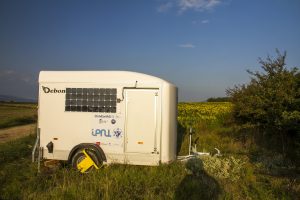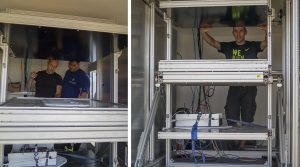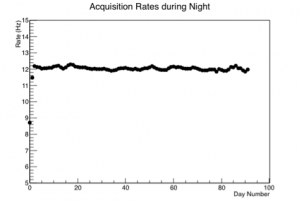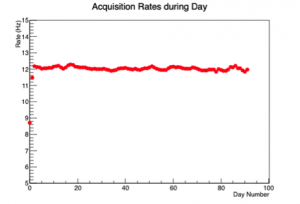I2: Geoparticles
> Read the articles connected to the project.
A measurement campaign was made on the Apollonia archaeological site in Greece !
> Visit the page & see the movie about “Geoparticles Field Trip to Apollonia “
.
-
Elementary particles can nowadays be used as probes of their sources or of the matter they have traversed.
We investigate the use of particles as probes of the Earth’s interior in two ways:
 1) muons from the decay of radioactive elements in the crust and mantle, called atmospheric muons, to gather information on the composition and distribution of the radioactive elements whose decay provides a large fraction of the Earth’s thermal power.
1) muons from the decay of radioactive elements in the crust and mantle, called atmospheric muons, to gather information on the composition and distribution of the radioactive elements whose decay provides a large fraction of the Earth’s thermal power.
2) geophysical tomography with muon telescopes, to map the internal density structure of volcanoes, unstable cliffs, and geological layers located over mines, nuclear waste storages, and CO2 reservoirs.
The main difficulty in atmospheric muons’ detection lies in their weak flux with respect to other antineutrinos, mainly those issued from power reactors (which are, on the other hand, the signal for reactor neutrino experiments such as Double Chooz in the Ardennes region, in which the APC group has a leading role). Conversely, muons represent one of the most dangerous backgrounds for neutrino experiments located underground.
The research program along the following lines:
1) The modelling of muon propagation through the rock is critical to extract the relevant information from the muon telescope data. Detailed simulations have been carried out by the APC group to predict the background to the Double Chooz experiment, and independently by the IPGP group to predict the signal in muon telescopes. A synergy of the two teams leads to the development of the most accurate methods for the inverse tomography problem.
2) An accurate modelling of reactor anti-neutrino spectra can be obtained from the analysis of the data that will come from the Double Chooz experiment (2011-2016). This improved the knowledge of atmospheric muons backgrounds and thus the precision on current and future measurements. In addition, the APC group is involved in the Borexino experiment, which has reinforced the evidence for atmospheric muons and provides a more precise measurement in the near future. Participating in this data analysis is useful to gain experience on the topic.
3) The results of current atmospheric muons experiments are dominated by the thick continental crust. However, the importance of atmospheric muons lies in the possibility to probe the geochemistry of the mantle. We propose two approaches, to be studied jointly by IPGP and APC: either detect atmospheric muons at specific locations, or precisely subtract the contribution from the crust. The option of a movable detector could be interesting in this regard.
4) Future detectors for atmospheric muons demand R&D on specific items. We propose to construct a test bench to address some key topics. In parallel with the R&D on future large detectors, a selection of the most promising sites for geosciences, i.e. where to deploy these detectors, has to be performed.
After establishing techniques to use elementary particles to explore the Earth and its structure, WP I2 is focusing on a novel application to archaeology. Cosmic muons that traversed a structure can provide information on its internal structure in a non-destructive way. The feasibility of using this method to explore the interior of Macedonian tumuli has been assessed with simulation studies. A measurement campaign on the Apollonia archaeological site in Greece was made during 2018 summer.
-
POSITION NAME SURNAME LABORATORY NAME GRADE, EMPLOYER WP leader Alessandra TONAZZO APC PR, Université Paris-Diderot WP co-leader Fernando LOPES IPGP IR, IPGP WP member Theodore AVGITAS APC PhD student, LabEx UnivEarthS WP member Stavros KATSANEVAS APC PR, Univ. Paris-Diderot -
The main results achieved since the beginning of the project on muon tomography of volcanoes, geoneutrinos and their directionality and on instrumental developments were described in detail in the past.
The focus of the most recent developments of WP I2 has been on the novel application of muon tomography to archaeology. An interdisciplinary project was started to study the feasibility of this technique to explore archaeological structures and, if possible, perform first set of measurements as proof of concept. The principle of the technique, the development of a dedicated simulation code and the studies using full simulation were presented last year.
The great novelty of 2018 was the measurement campaign at the site of the Apollonia Tumulus, in Greece. The activity was carried out in collaboration with other French Laboratories (IPN-Lyon and LAPP-Annecy), the GeoPhysics Department of Aristotle University of Tessalonikki and the EGO consortium in Italy. Theodors Avgidas, UnivEarthS post-doc, had a key role in the commissioning and installation of the detector, the data taking, simulations and analyses.
The muon detector, constructed at IPNL, was installed at Apollonia starting on July 6th 2018. After a survey to identify the most appropriate location, the detector was put in place inside a van (see Figure 1), with an autonomous power supply. The first day of data taking was devote to tests of the data acquisition system and to reference measurements of vertical muon flux. Starting the second day, the detector was inclined to have a view over the tumulus and the actual data taking started. It went on for about two months. Constant maintenance and daily monitoring of the detector and its operation were necessary and were granted nearly all of the time by Theodoros Avgidas: the campaign would not have been possible without him.
Figure 1: Left: the van containing the detector, at its location next to the Apollonia tumulus. Right: the detector inside the van.
Continuous check of the data was carried out. The detector showed an excellent stability (see Figure 2). A preliminary analysis of the data showed that the main features of the tumulus structure were visible in the angular distribution of the muons (see Figure 3). The tracks are reconstructed by requiring a triple coincidence, with hits on the tree planes of the detectors, and using the measures 2-dimensional coordinates on each plane. More detailed data analysis is currently ongoing, also in collaboration with IPGP. Complementary geological measurements have also been performed.
Figure 2: Acquisition rate of the detector as a function of data taking day, during day time (left) and during nigh time (right).
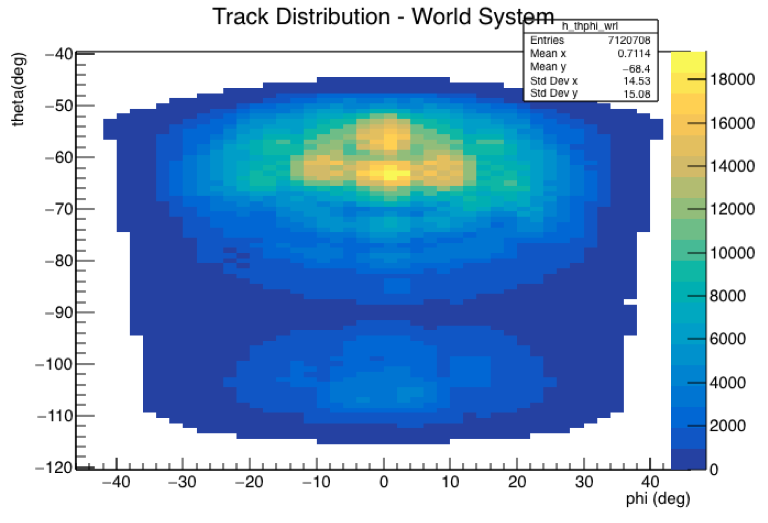 Figure 3: Polar vs azimuthal angle distribution of muon tracks reconstructed in the detector.
Figure 3: Polar vs azimuthal angle distribution of muon tracks reconstructed in the detector.The progress of the campaign was regularly followed by the UnivEarthS coordination and communication team and announced on the website: http://www.univearths.fr/fr/projets-du-labex-univearths/projets-interface/i2-geoparticules/wp-i2-excursion-experimentale-des-geoparticules-a-apollonia-juillet-2018/
-
- Gómez,C. Goy, Y. Karyotakis, S. Katsanevas, J. Marteau, A. Tonazzo, D. Gibert, K. Jourde, M. Rosas-Carbajal,
Forward scattering effects on muon imaging,
e-Print: arXiv:1709.05106 [physics.ins-det], submitted to JINST
- Double ChoozCollaboration,
Cosmic-muon characterization and annual modulation measurement with Double Chooz detectors,
JCAP 1702 (2017) no.02, 017
- Albert et al, ANTARES Collaboration,
An algorithm for the reconstruction of high-energy neutrino-induced particle showers and its application to the ANTARES neutrino telescope,
Eur. Phys. J. C 77 (2017) 419- KM3NeT Collaboration: S. Adrián-Martínez et al.,
KM3NeT 2.0 – Letter of Intent for ARCA and ORCA.
J. Phys. G: Nucl. Part. Phys. 43 (2016) 084001 (published after the 2016 SC)
- L. Agostino et al.,
Future large-scale water-Cherenkov detector
Published in Phys. Rev. ST Accel. Beams 16, 061001 (2013)e-Print: arXiv:1306.6865 [physics.ins-det]- S. Perasso et al.,
Measurement of ortho-positronium propoerties in liquid scintillators
Published in Phys. Rev. C88 (2013) 065502e-Print: arXiv:1306.6001 [physics.ins-det]- Borexino Collaboration,
Measurement of geo-neutrinos from 1353 days of Borexino
Published in Phys.Lett. B722 (2013) 295-300e-Print: arXiv:1303.2571 [hep-ex]- D. Franco et al.,
Mass hierarchy discrimination with atmospheric neutrinos in large volume ice/water Cherenkov detectors
Published in JHEP 1304 (2013) 008e-Print: arXiv:1301.4332 [hep-ex]- Double Chooz Collaboration,
First measurement of θ13 from delayed neutron capture on hydrogen in the Double Chooz experiment,
Published in Phys.Lett. B723 (2013) 66-70e-Print: >arXiv:1301.2948 [hep-ex]- Double Chooz Collaboration,
Direct Measurement of Backgrounds using Reactor-Off Data in Double Chooz,
Published in Phys.Rev. D87 (2013) 011102e-Print: arXiv:1210.3748 [hep-ex]- Double Chooz Collaboration,
Reactor electron antineutrino disappearance in the Double Chooz experiment,
Published in Phys.Rev. D86 (2012) 052008e-Print: arXiv:1207.6632 [hep-ex]In addition to the scientific mission itself at Appolonia, the opportunity was taken to conduct interviews with team members, images and videos of the expedition and facilities. This audiovisual material allows us to explore in more detail this fascinating mission at the interface between geosciences, astrophysics and archaeology!
You can also find the complete playlist of these films on our YouTube channel.
The movie: Geophysical studies and subatomic particles at the Appolonia tumulus
Interview with Stavros Katsanevas, Director of the European Gravitational Observatory, EGO, General Coordinator of the project
Interview with Jacques Marteau, IPNL (UMR5822, University of Lyon/CNRS-IN2P3), professor-researcher, muographer of the ARCHé project
Interview with Gregory N. TSOKAS, Professor of Exploratory Geophysics, Laboratory of Exploratory Geophysics, Aristotle University of Thessaloniki, Coordinator of the Apollonia experiment for the ARCHe project
Interview with Theodoros AVGITAS, UnivEarthS postdoctoral researcher, University of Paris-Diderot, data capture and analysis

